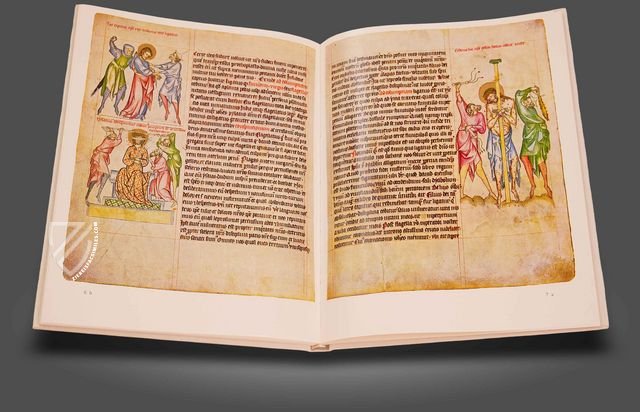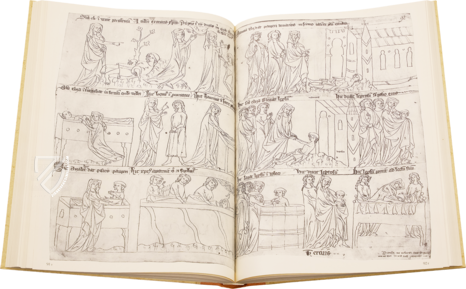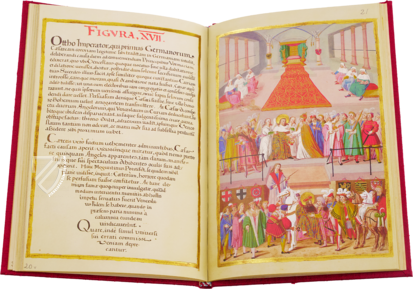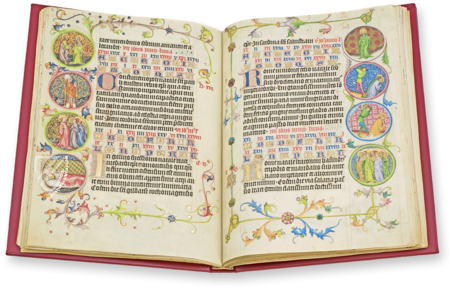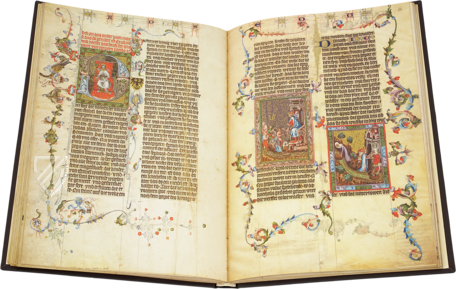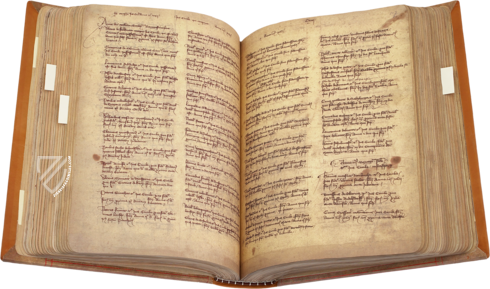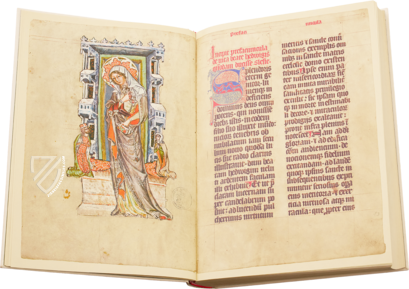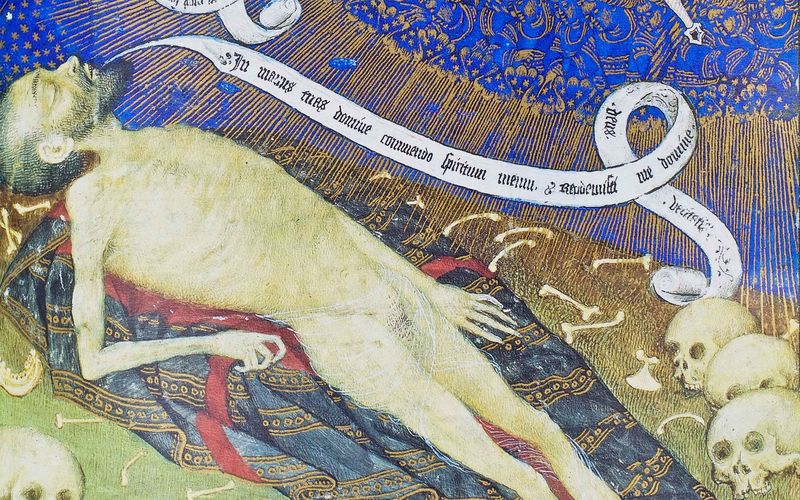Passional of Abbess Kunegunda
(under 1,000€)
The Passionale Abbatissae Cunegundis (English: Passional of Abbess Kunigunde) was created sometime between 1312 and 1321. It is named after its patron, the Benedictine Abbess Kunigunde of Bohemia, daughter of King Ottokar II of Bohemia. Considered to be a monument of Czech culture today, the manuscript is an anthology of various mystic treatises concerning the Passion, two of which were authored by the Czech Dominican friar Kolda of Koldice. The Prague canon and priest in St. George’s convent Beneš served as the scribe and possible illuminator of the manuscript, which is noteworthy inter alia for containing the oldest surviving depiction of the Bohemian coat of arms in color.
Passional of Abbess Kunegunda
This manuscript containing a set of five spiritual texts from the beginning of the 14th century was created at the initiative of Kunigunde of Bohemia (1265–1321), a member of the Přemyslid dynasty and Princess of Masovia who became Abbess of St. George's Convent at Prague Castle later in life. The first text was written ca. 1312, illumination of the work began the following year, and the manuscript was completed ca. 1321. Consisting of 26 illuminated pages including 5 full-page miniatures, the artistic décor of the manuscript is one of the finest examples of illumination at the time, not only in Central Europe, but is the equal of any contemporary work of book art.
It is believed to be the work of the canon and scribe Beneš, who served as a priest in the St. George's Convent. Created with a bright color palette, the naturalistic figures are dressed in elegant flowing robes and tights while some of the figures are adorned by golden halos and crowns. As a reminder that the theme connecting the five texts of this manuscript masterpiece is the Passion, the Arma Christi are depicted in detail in two of the full-page miniatures.
Historic Illumination
The illumination of this manuscript is not only important for art historians because of its exceptional quality, but also because it is historically significant. Its dedication picture depicting Abbess Kunigunde on a throne with the coats of arms of Bohemia and the Přemyslids is the earliest surviving colored depiction of the heraldic emblem of Bohemia, which serves today the Lesser coat of arms of the Czech Republic. Furthermore, the manuscript dates from a time when the fortunes of Bohemia and the Czech people were rising.
The Přemyslid dynasty had founded Bohemia as a duchy and transformed it into a kingdom in the previous century, but their male line died out in the early 14th century and the last female heir was married to a member of the House of Luxembourg in 1310. During the 14th and 15th centuries, Bohemia became a center of power in the Holy Roman Empire and Prague evolved into a center of art and culture. For these reasons, the manuscript was declared a National Cultural Monument in 2005 by the Czech government.
The Life of the Patron
Kunigunde was the eldest daughter of Ottokar II of Bohemia (ca. 1233–78) and his second wife, Kunigunda of Slavonia (1245–85), after his first marriage was annulled because he and his wife, who was 26 years his senior, were unable to produce a child. She was initially betrothed to the son of King Rudolf I of Germany, the first Habsburg to sit on the throne, as a political marriage to create peace between the two dynasties, but the engagement was called off after a year and her brother Wenceslaus and her sister Agnes would eventually marry Habsburgs to secure the alliance.
Free to do as she pleased, Kunigunde assumed the habit of the Order of Saint Clare in Prague, where she happily remained for a couple of years until her brother, who was now Kingof Bohemia, ordered her to marry Bolesław II of Masovia (ca. 1253/58–1313). They were married in 1291 and proceeded to have two children but although the resulting alliance worked at first, a dispute over land arose between Kunigunde’s brother and husband. Bolesław withdrew his support for Wenceslaus’ rule and sent Kunigunde back to Prague and they were divorced in 1302.
Once again freed from marital obligations, she returned to religious life at St. George’s, of which she eventually became abbess. It was during her time as abbess that she commissioned the now famous Passionale Abbatissae Cunegundis.
Codicology
- Alternative Titles
- Pasional abatyse Kunhunty
Pasionál Přemyslovny Kunhuty
Passionale Abbatissae Cunegundis
Passionsgeschichte der Äbtissin Kunegunda - Size / Format
- 74 pages / 30.0 × 25.0 cm
- Origin
- Czech Republic
- Date
- 1313–1321
- Epochs
- Style
- Genre
- Language
- Script
- Gothic Textura
- Illustrations
- 26 miniatures and dozens of pen-flourish initials
- Content
- Anthology of five mystic treatises concerning the Passion of Christ
- Patron
- Kunigunde of Bohemia (1265–1321)
- Artist / School
- Beneš (scribe and illuminator)
Kolda of Koldice (author)
- Treatises / Secular Books
- Apocalypses / Beatus
- Astronomy / Astrology
- Bestiaries
- Bibles / Gospels
- Chronicles / History / Law
- Geography / Maps
- Saints' Lives
- Islam / Oriental
- Judaism / Hebrew
- Single Leaf Collections
- Leonardo da Vinci
- Literature / Poetry
- Liturgical Manuscripts
- Medicine / Botany / Alchemy
- Music
- Mythology / Prophecies
- Psalters
- Other Religious Books
- Games / Hunting
- Private Devotion Books
- Other Genres
- Afghanistan
- Armenia
- Austria
- Belgium
- Belize
- Bosnia and Herzegovina
- China
- Colombia
- Costa Rica
- Croatia
- Cyprus
- Czech Republic
- Denmark
- Egypt
- El Salvador
- Ethiopia
- France
- Germany
- Greece
- Guatemala
- Honduras
- Hungary
- India
- Iran
- Iraq
- Israel
- Italy
- Japan
- Jordan
- Kazakhstan
- Kyrgyzstan
- Lebanon
- Liechtenstein
- Luxembourg
- Mexico
- Morocco
- Netherlands
- Palestine
- Panama
- Peru
- Poland
- Portugal
- Romania
- Russia
- Serbia
- Spain
- Sri Lanka
- Sweden
- Switzerland
- Syria
- Tajikistan
- Turkey
- Turkmenistan
- Ukraine
- United Kingdom
- United States
- Uzbekistan
- Vatican City
- A. Oosthoek, van Holkema & Warendorf
- Aboca Museum
- Ajuntament de Valencia
- Akademie Verlag
- Akademische Druck- u. Verlagsanstalt (ADEVA)
- Aldo Ausilio Editore - Bottega d’Erasmo
- Alecto Historical Editions
- Alkuin Verlag
- Almqvist & Wiksell
- Amilcare Pizzi
- Andreas & Andreas Verlagsbuchhandlung
- Archa 90
- Archiv Verlag
- Archivi Edizioni
- Arnold Verlag
- ARS
- Ars Magna
- ArtCodex
- AyN Ediciones
- Azimuth Editions
- Badenia Verlag
- Bärenreiter-Verlag
- Belser Verlag
- Belser Verlag / WK Wertkontor
- Benziger Verlag
- Bernardinum Wydawnictwo
- BiblioGemma
- Biblioteca Apostolica Vaticana (Vaticanstadt, Vaticanstadt)
- Bibliotheca Palatina Faksimile Verlag
- Bibliotheca Rara
- Boydell & Brewer
- Bramante Edizioni
- Bredius Genootschap
- Brepols Publishers
- British Library
- C. Weckesser
- Caixa Catalunya
- Canesi
- CAPSA, Ars Scriptoria
- Caratzas Brothers, Publishers
- Carus Verlag
- Casamassima Libri
- Centrum Cartographie Verlag GmbH
- Chavane Verlag
- Christian Brandstätter Verlag
- Circulo Cientifico
- Club Bibliófilo Versol
- Club du Livre
- CM Editores
- Collegium Graphicum
- Collezione Apocrifa Da Vinci
- Comissão Nacional para as Comemorações dos Descobrimentos Portugueses
- Coron Verlag
- Corvina
- CTHS
- D. S. Brewer
- Damon
- De Agostini/UTET
- De Nederlandsche Boekhandel
- De Schutter
- Deuschle & Stemmle
- Deutscher Verlag für Kunstwissenschaft
- DIAMM
- Droz
- E. Schreiber Graphische Kunstanstalten
- Ediciones Boreal
- Ediciones Grial
- Ediclube
- Edições Inapa
- Edilan
- Editalia
- Edition Deuschle
- Edition Georg Popp
- Edition Leipzig
- Edition Libri Illustri
- Editiones Reales Sitios S. L.
- Éditions de l'Oiseau Lyre
- Editions Medicina Rara
- Editorial Casariego
- Editorial Mintzoa
- Editrice Antenore
- Editrice Velar
- Edizioni Edison
- Egeria, S.L.
- Eikon Editores
- Electa
- Emery Walker Limited
- Enciclopèdia Catalana
- Eos-Verlag
- Ephesus Publishing
- Ernst Battenberg
- Eugrammia Press
- Extraordinary Editions
- Fackelverlag
- Facsimila Art & Edition
- Facsimile Editions Ltd.
- Facsimilia Art & Edition Ebert KG
- Faksimile Verlag
- Feuermann Verlag
- Folger Shakespeare Library
- Franco Cosimo Panini Editore
- Friedrich Wittig Verlag
- Fundación Hullera Vasco-Leonesa
- G. Braziller
- Gabriele Mazzotta Editore
- Gebr. Mann Verlag
- Gesellschaft für graphische Industrie
- Getty Research Institute
- Giovanni Domenico de Rossi
- Giunti Editore
- Graffiti
- Grafica European Center of Fine Arts
- Guido Pressler
- Guillermo Blazquez
- Gustav Kiepenheuer
- H. N. Abrams
- Harrassowitz
- Harvard University Press
- Helikon
- Hendrickson Publishers
- Henning Oppermann
- Herder Verlag
- Hes & De Graaf Publishers
- Hoepli
- Holbein-Verlag
- Houghton Library
- Hugo Schmidt Verlag
- Idion Verlag
- Il Bulino, edizioni d'arte
- ILte
- Imago
- Insel Verlag
- Insel-Verlag Anton Kippenberger
- Instituto de Estudios Altoaragoneses
- Instituto Nacional de Antropología e Historia
- Istituto dell'Enciclopedia Italiana - Treccani
- Istituto Ellenico di Studi Bizantini e Postbizantini
- Istituto Geografico De Agostini
- Istituto Poligrafico e Zecca dello Stato
- Italarte Art Establishments
- Jan Thorbecke Verlag
- Johnson Reprint Corporation
- Josef Stocker
- Josef Stocker-Schmid
- Jugoslavija
- Karl W. Hiersemann
- Kasper Straube
- Kaydeda Ediciones
- Kindler Verlag / Coron Verlag
- Kodansha International Ltd.
- Konrad Kölbl Verlag
- Kurt Wolff Verlag
- La Liberia dello Stato
- La Linea Editrice
- La Meta Editore
- Lambert Schneider
- Landeskreditbank Baden-Württemberg
- Leo S. Olschki
- Les Incunables
- Liber Artis
- Library of Congress
- Libreria Musicale Italiana
- Lichtdruck
- Lito Immagine Editore
- Lumen Artis
- Lund Humphries
- M. Moleiro Editor
- Maison des Sciences de l'homme et de la société de Poitiers
- Manuscriptum
- Martinus Nijhoff
- Maruzen-Yushodo Co. Ltd.
- MASA
- Massada Publishers
- McGraw-Hill
- Metropolitan Museum of Art
- Militos
- Millennium Liber
- Müller & Schindler
- Nahar - Stavit
- Nahar and Steimatzky
- National Library of Wales
- Neri Pozza
- Nova Charta
- Oceanum Verlag
- Odeon
- Orbis Mediaevalis
- Orbis Pictus
- Österreichische Staatsdruckerei
- Oxford University Press
- Pageant Books
- Parzellers Buchverlag
- Patrimonio Ediciones
- Pattloch Verlag
- PIAF
- Pieper Verlag
- Plon-Nourrit et cie
- Poligrafiche Bolis
- Presses Universitaires de Strasbourg
- Prestel Verlag
- Princeton University Press
- Prisma Verlag
- Priuli & Verlucca, editori
- Pro Sport Verlag
- Propyläen Verlag
- Pytheas Books
- Quaternio Verlag Luzern
- Reales Sitios
- Recht-Verlag
- Reichert Verlag
- Reichsdruckerei
- Reprint Verlag
- Riehn & Reusch
- Roberto Vattori Editore
- Rosenkilde and Bagger
- Roxburghe Club
- Salerno Editrice
- Saltellus Press
- Sandoz
- Sarajevo Svjetlost
- Schöck ArtPrint Kft.
- Schulsinger Brothers
- Scolar Press
- Scrinium
- Scripta Maneant
- Scriptorium
- Shazar
- Siloé, arte y bibliofilia
- SISMEL - Edizioni del Galluzzo
- Sociedad Mexicana de Antropología
- Société des Bibliophiles & Iconophiles de Belgique
- Soncin Publishing
- Sorli Ediciones
- Stainer and Bell
- Studer
- Styria Verlag
- Sumptibus Pragopress
- Szegedi Tudomànyegyetem
- Taberna Libraria
- Tarshish Books
- Taschen
- Tempus Libri
- Testimonio Compañía Editorial
- Thames and Hudson
- The Clear Vue Publishing Partnership Limited
- The Facsimile Codex
- The Folio Society
- The Marquess of Normanby
- The Richard III and Yorkist History Trust
- Tip.Le.Co
- TouchArt
- TREC Publishing House
- TRI Publishing Co.
- Trident Editore
- Tuliba Collection
- Typis Regiae Officinae Polygraphicae
- Union Verlag Berlin
- Universidad de Granada
- University of California Press
- University of Chicago Press
- Urs Graf
- Vallecchi
- Van Wijnen
- VCH, Acta Humaniora
- VDI Verlag
- VEB Deutscher Verlag für Musik
- Verlag Anton Pustet / Andreas Verlag
- Verlag Bibliophile Drucke Josef Stocker
- Verlag der Münchner Drucke
- Verlag für Regionalgeschichte
- Verlag Styria
- Vicent Garcia Editores
- W. Turnowski Ltd.
- W. Turnowsky
- Waanders Printers
- Wiener Mechitharisten-Congregation (Wien, Österreich)
- Wissenschaftliche Buchgesellschaft
- Wissenschaftliche Verlagsgesellschaft
- Wydawnictwo Dolnoslaskie
- Xuntanza Editorial
- Zakład Narodowy
- Zollikofer AG

